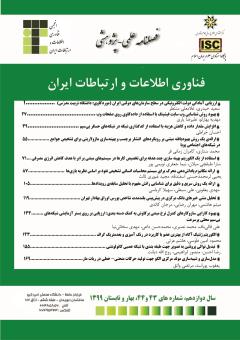استفاده از یک الگوریتم بهینهسازی چند هدفه برای تخصیص کارها در سیستمهای مبتنی بر ابر با هدف کاهش انرژی مصرفی
محورهای موضوعی : عمومیسارا طبقچی میلان 1 , نیما جعفری نویمی پور 2
1 - گروه مهندسی کامپیوتر، واحد تبریز، دانشگاه آزاد اسلامی، تبریز، ایران
2 - گروه مهندسی کامپیوتر، واحد تبریز، دانشگاه آزاد اسلامی، تبریز، ایران
کلید واژه: رایانش ابری, انرژی مصرفی, تخصیص کار, الگوریتم بهینهسازی چند هدفه,
چکیده مقاله :
افزایش تقاضا منجر به افزایش تنوع، تعداد خدمات و درنتیجه ایجاد مراکز داده رایانش با مقیاس بزرگشده است که علاوه بر هزینههای عملیاتی بالا، مقادیر عظیمی از توان الکتریکی را مصرف میکند. از طرفی سیستمهای خنککننده ناکافی و ناکارآمد، نهتنها باعث گرم شدن بیشازحد منابع و کاهش عمر کاری دستگاهها میشود، بلکه باعث تولید کربن شده که در وضعیت آبوهوا نقش مهمی دارد. ازاینرو، در این پژوهش، یک روش مؤثر مدیریت منابع انرژی در مراکز داده ابری مجازی شده ارائهشده که علاوه بر کاهش مصرف انرژی و هزینههای عملیاتی، باعث افزایش کیفیت خدمات نیز شده است. این پژوهش، به ارائه یک استراتژی تخصیص منبع در سیستمهای ابری باهدف کاهش انرژی و هزینه اجرا پرداخته و کاربرد آن را در محیط رایانش ابری بررسی میکند. نتایج حاصل از شبیهسازی نشان میدهد که روش پیشنهادی میتواند نسبت به روشهای NPA[1]، [2]DVFS، [3]ST و [4]MM ، میانگین انرژی مصرفی را تا 0.626 کیلووات ساعت کاهش دهد، همچنین نیاز به مهاجرت و موارد نقض SLA نیز به ترتیب به 186 و 30.91% کاهش پیدا نمود.
Nowadays, new technologies have increased the demand for business in the web environment.Increasing demand will increase the variety and number of services. As a result, the creation of large-scale computing data centers has high operating costs and consumes huge amounts of electrical power. On the other hand, inadequate and inadequate cooling systems not only cause excessive heating of resources and shorten the life of the machines. It also produces carbon that plays an important role in the weather. Therefore, they should reduce the total energy consumption of these systems with proper methods. In this research, an efficient energy management approach is provided in virtual cloud data centers, which reduces energy consumption and operational costs, and brings about an increase in the quality of services. It aims to provide a resource allocation strategy for cloud systems with the goal of reducing energy, cost of implementation and examining its use in cloud computing. The results of the simulation show that the proposed method in comaprision to NPA, DVFS, ST and MM methods can reduce the average energy consumption up to 0.626 kWh, also the need to immigration and SLA violation declined up to 186 and 30.91% respectively.
